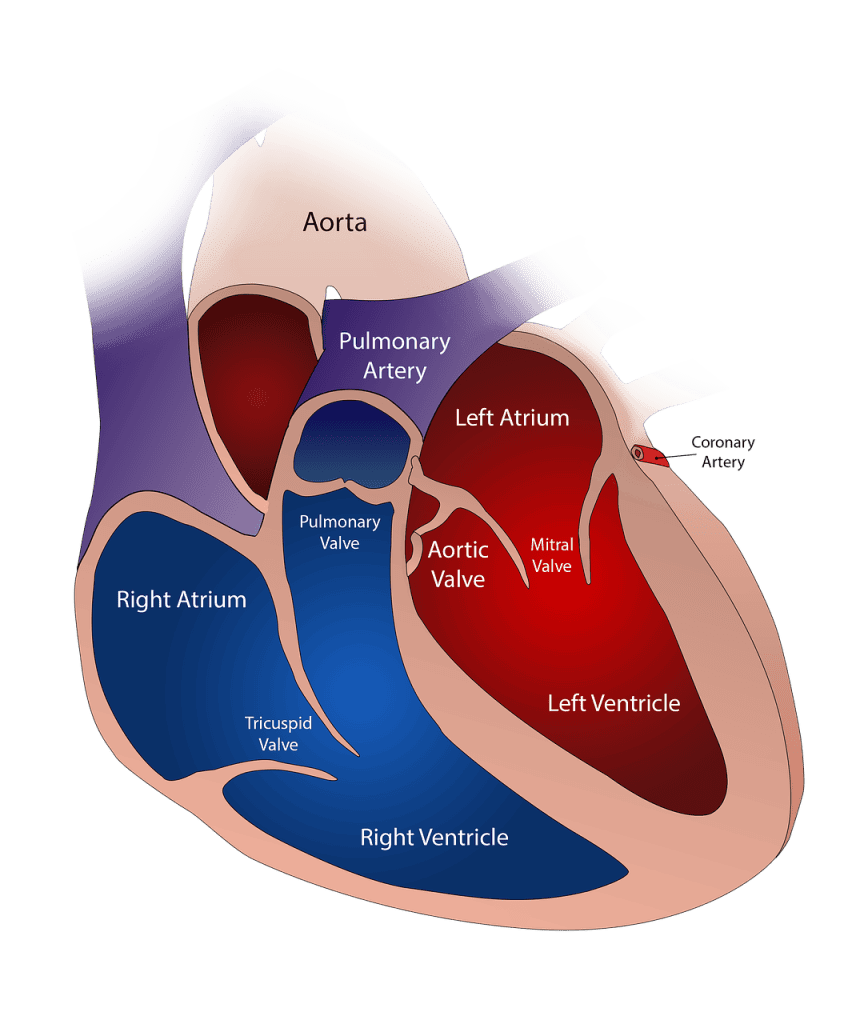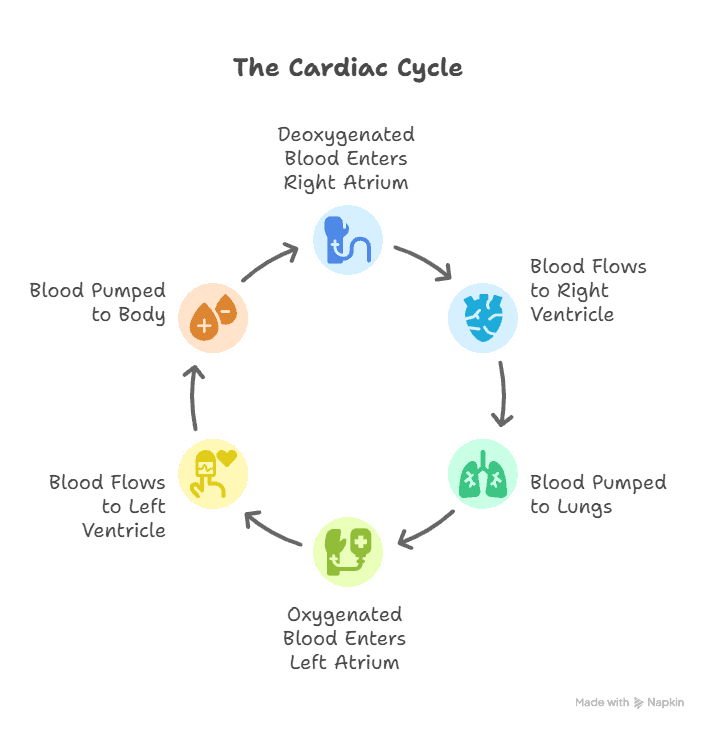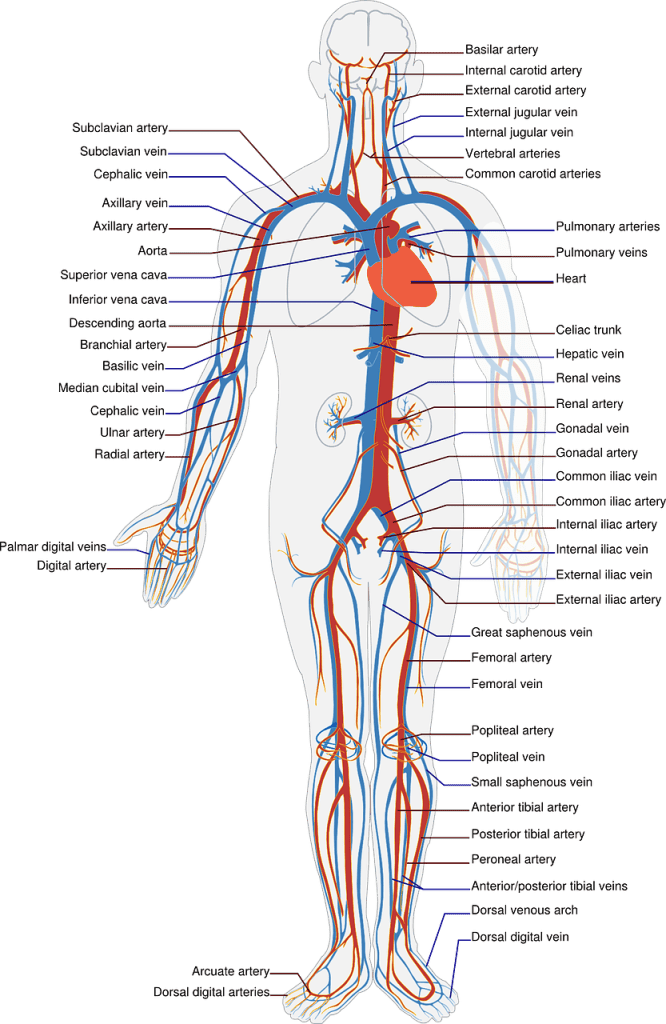Welcome to the Cardiovascular System learning module! In this module, we will examine the crucial role that the cardiovascular system plays in maintaining our bodies’ health and proper functioning. The cardiovascular system comprises the heart, blood vessels, and blood, and it is responsible for pumping blood throughout the body to deliver oxygen and nutrients to cells.
Objectives:
By the end of this module, you will be able to:
- Identify the main components of the cardiovascular system
- Understand the functions of the heart, blood vessels, and blood
- Explain the importance of maintaining a healthy cardiovascular system
- Describe common cardiovascular diseases and their prevention
Section 1: Anatomy of the Heart
Chambers of the Heart
The Chambers of the Heart are four spaces inside the heart where blood flows through.
There are two upper chambers, called the atria, and two lower chambers, called the ventricles. The atria receive blood from the body and lungs, while the ventricles pump blood out to the body and lungs.
Each chamber plays a crucial role in maintaining the smooth flow of blood through the heart.

| Chamber | Definition |
|---|---|
| Right Atrium | Receives deoxygenated blood from the body and pumps it to the right ventricle. |
| Right Ventricle | Receives deoxygenated blood from the right atrium and pumps it to the lungs for oxygenation. |
| Left Atrium | Receives oxygenated blood from the lungs and pumps it to the left ventricle. |
| Left Ventricle | Receives oxygenated blood from the left atrium and pumps it to the rest of the body. |
Valves of the Heart
The heart has four valves that help control the flow of blood. These valves are like doors that open and close to let blood pass through.
The valves are named the mitral valve, tricuspid valve, aortic valve, and pulmonic valve.
Each valve plays a crucial role in ensuring that blood flows in the correct direction through the heart. If a valve doesn’t work correctly, it can cause problems with how the heart functions.

| Valve | Definition |
|---|---|
| Tricuspid Valve | The tricuspid valve is located between the right atrium and right ventricle of the heart. It prevents backflow of blood from the right ventricle to the right atrium. |
| Pulmonary Valve | The pulmonary valve is located between the right ventricle and the pulmonary artery. It prevents backflow of blood from the pulmonary artery to the right ventricle. |
| Mitral Valve | The mitral valve is located between the left atrium and left ventricle of the heart. It prevents backflow of blood from the left ventricle to the left atrium. |
| Aortic Valve | The aortic valve is located between the left ventricle and the aorta. It prevents backflow of blood from the aorta to the left ventricle. |
Blood Flow Through the Heart
In the heart, blood flows in a continuous loop, traveling through four chambers. The right atrium receives oxygen-poor blood from the body and sends it to the right ventricle. From there, the blood is pumped to the lungs to pick up oxygen.
The left atrium then receives the oxygen-rich blood from the lungs and sends it to the left ventricle. Finally, the left ventricle pumps the oxygen-rich blood back out to the body to deliver nutrients and oxygen. This cycle repeats continuously, keeping the body supplied with the vital oxygen it needs to function.

| Step | Definition |
|---|---|
| 1. Deoxygenated blood enters the right atrium | Blood returning from the body enters the heart through the vena cava and flows into the right atrium. |
| 2. Blood flows from the right atrium to the right ventricle | When the right atrium contracts, it pushes blood through the tricuspid valve into the right ventricle. |
| 3. Blood is pumped to the lungs for oxygenation | The right ventricle contracts, sending deoxygenated blood through the pulmonary valve to the lungs via the pulmonary artery. |
| 4. Oxygenated blood returns to the heart | Oxygenated blood from the lungs enters the left atrium through the pulmonary veins. |
| 5. Blood flows from the left atrium to the left ventricle | When the left atrium contracts, it pushes blood through the mitral valve into the left ventricle. |
| 6. Blood is pumped to the body | The left ventricle contracts, sending oxygenated blood through the aortic valve to the rest of the body via the aorta. |
Games and Activities
Section 2: Blood Vessels
1. Arteries and Veins
Arteries and veins are two types of blood vessels in our body.
Arteries carry oxygen-rich blood away from the heart to the rest of the body. They have thick, muscular walls to withstand the force of the pumping heart.
Veins, on the other hand, carry oxygen-poor blood back to the heart. They have thinner walls and valves to prevent blood from flowing backwards. Both arteries and veins play crucial roles in circulating blood throughout the body and maintaining our health.
2. Capillaries
Capillaries are tiny blood vessels in our bodies that connect arteries and veins. They are tiny, only about the width of a single red blood cell.
Capillaries are where the exchange of oxygen, nutrients, and waste products happens between the blood and the body’s tissues.
These exchanges are crucial for maintaining the health and proper functioning of our cells. Without capillaries, our bodies would be unable to obtain the oxygen and nutrients necessary for survival.
3. Blood Pressure
Blood pressure is regulated by the heart, blood vessels, and kidneys. When the heart beats, it pumps blood into the arteries, which causes pressure. The blood vessels can constrict or dilate to adjust to this pressure.
The kidneys also play a role by controlling the amount of water and salt in the body. Blood pressure is crucial in circulation because it helps push blood through the body, delivering oxygen and nutrients to all cells.
If blood pressure is too high or too low, it can lead to health problems like heart disease or organ damage. It is essential to monitor and regulate blood pressure to maintain good overall health.
Games and Activities
Section 3: Cardiovascular Diseases
Atherosclerosis
Atherosclerosis is a condition where plaque builds up in the arteries, causing them to become narrow and stiff. This can lead to decreased blood flow to the heart, brain, and other organs.
Causes of atherosclerosis include high cholesterol, high blood pressure, smoking, and diabetes. The effects of atherosclerosis on the cardiovascular system can be severe, including heart attacks, strokes, and peripheral artery disease. Maintaining a healthy lifestyle is crucial for preventing and managing atherosclerosis.
Hypertension
High blood pressure, also known as hypertension, can have various risk factors that can increase the chances of developing this condition. These risk factors include genetics, poor diet, lack of exercise, obesity, and smoking.
If left untreated, hypertension can lead to serious complications such as heart disease, stroke, kidney damage, and vision loss. It is essential to monitor blood pressure regularly and make lifestyle changes to reduce the risk of developing hypertension and its complications.
Heart Failure
Heart failure occurs when the heart is not able to pump enough blood to meet the body’s needs. This can happen due to various reasons such as high blood pressure, heart attacks, or diseases of the heart valves.
When the heart fails, the body does not get enough oxygen and nutrients, leading to symptoms like tiredness, shortness of breath, and swelling in the legs.
Over time, heart failure can weaken the body, making it harder to perform daily activities. It can also lead to complications like kidney problems, irregular heartbeats, and even death if not appropriately managed.
Games and Activities

Conclusion
You’ve completed the learning module on the Cardiovascular System! Throughout this module, you have learned about the following objectives:
- Understanding the function of the heart
- Identifying the different parts of the cardiovascular system
- Exploring the importance of blood vessels
- Learning about how the cardiovascular system works to circulate blood
By completing this module, you will gain a deeper understanding of how the cardiovascular system functions and its crucial role in maintaining bodily health. Keep up the good work!
What to Study Next?
It is recommended that you study the respiratory system next. This system works closely with the cardiovascular system to help you breathe and bring oxygen to your body.
By understanding how the respiratory system works, you will gain a deeper understanding of how your body functions as a whole.
Take time to learn about the different parts of the respiratory system, such as the lungs and diaphragm, and how they work together to keep you alive and healthy.
